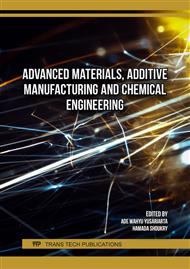[1]
Xu, Y., et al., Highly thermo-stable resveratrol-based flame retardant for enhancing mechanical and fire safety properties of epoxy resins, Chemical Engineering Journal 450 (4) (2022) 138475
DOI: 10.1016/j.cej.2022.138475
Google Scholar
[2]
Totosko, O.V., et al., Investigation of electrospark hydraulic shock influence on adhesive-cohesion characteristics of epoxy coatings, Funct. Mater. 27 (4) (2020) 760-766
DOI: 10.15407/fm27.04.760
Google Scholar
[3]
Dolgov N., et al., Analytical stress analysis of the furan epoxy composite coatings subjected to tensile test, Mechanics of Advanced Materials and Structure 31 (25) (2024) 6874-6884
DOI: 10.1080/15376494.2023.2239811
Google Scholar
[4]
Sapronov, О., et al., Development and Use of New Polymer Adhesives for the Restoration of Marine Equipment Units, Journal of Marine Science and Engineering 8 (7) (2020) 527
DOI: 10.3390/jmse8070527
Google Scholar
[5]
Bekeshev, A., et al., Reinforcement of epoxy composites with application of finely-ground ochre and electrophysical method of the composition modification, Polymers 12 (7) (2020) 1437
DOI: 10.3390/polym12071437
Google Scholar
[6]
Dobrotvor, I.G., et al., Influence of Thickness and Dispersed Impurities on Residual Stresses in Epoxy Composite Coatings. Strength Mater 53 (2021) 283–290
DOI: 10.1007/s11223-021-00287-x
Google Scholar
[7]
Buketov, A., et al., The use of complex additives for the formation of corrosion- and wear-resistant epoxy composites, Advances in Materials Science and Engineering 2019 (2019), 8183761
DOI: 10.1155/2019/8183761
Google Scholar
[8]
Stukhlyak, P.D., et al., Investigation of the adhesive strength and residual stresses in epoxy composites modified by microwave electromagnetic treatment. Materials Science 5 (12) (2015) 208-212
DOI: 10.1007/s11003-015-9830-z
Google Scholar
[9]
Stukhlyak, P.D., et al., Influence of porosity in the epoxy matrix-polyvinyl alcohol-disperse filler system on the impact toughness. Materials Science 46(4) (2011) 455-463
DOI: 10.1007/s11003-011-9312-x
Google Scholar
[10]
Rajawat, A.S., et al., Effect of Marble Dust on the Mechanical, Morphological, and Wear Performance of Basalt Fibre-Reinforced Epoxy Composites for Structural Applications, Polymers 14 (7) (2022) 1325
DOI: 10.3390/polym14071325
Google Scholar
[11]
Buketov, A.V., et al., Increasing the Lifetime of Water Transportation Vehicles by Using Multifunctional Composites with a Polymer Matrix, Ultradisperse Diamond, and Discrete Fibrous Filler, Journal of Superhard Materials 46 (1), (2024) 40–54
DOI: 10.3103/S1063457624010027
Google Scholar
[12]
Hidalgo, P., et al., Influence of Biochar and Bio-Oil Loading on the Properties of Epoxy Resin Composites, Polymers 15 (8) (2023) 1895
DOI: 10.3390/polym15081895
Google Scholar
[13]
Pipeline and Hazardous Materials Safety Administration, Coatings for corrosion protection. Offshore oil and gas operation facilities, Accessed: 21.08.2024. Available at: https://primis.phmsa.dot.gov/rd/mtgs/060905/ACW03_Olson_CSM-2.pdf.
Google Scholar
[14]
Egbo, M.K. A fundamental review on composite materials and some of their applications in biomedical engineering, Journal of King Saud University - Engineering Sciences 33 (8) (2021) 557-568
DOI: 10.1016/j.jksues.2020.07.007
Google Scholar
[15]
Ye, G., et al., Durable flame-retardant, strong and tough epoxy resins with well-preserved thermal and optical properties via introducing a bio-based, phosphorus-phosphorus, hyperbranched oligomer, Polymer Degradation and Stability 207 (2023) 110235
DOI: 10.1016/j.polymdegradstab.2022.110235
Google Scholar
[16]
Sizonenko, O., et al., Variation in the particle size of Fe–Ti–B4C powders induced by high-voltage electrical discharge, Powder Metallurgy and Metal Ceramics 51(3) (2012) 129–136.
DOI: 10.1007/s11106-012-9407-4
Google Scholar
[17]
Buketov, A., et al., Increasing the reliability of water transport via the usage of modified epoxy coatings, Communications - Scientific Letters of the University of Zilina 26 (1) (2024) B1-B10
DOI: 10.26552/com.C.2024.001
Google Scholar
[18]
Sapronov, O.O., et al., Corrosion-Resistant Epoxy Coatings Filled with Nanoparticles of Vegetable Origin to Protect Water Vehicles, Journal of Nano- and Electronic Physics 15 (5) (2023) 1-7
DOI: 10.21272/jnep.15(5).05025
Google Scholar
[19]
Samsudin, S.S., et al., Physical, Thermal Transport, and Compressive Properties of Epoxy Composite Filled with Graphitic-and Ceramic-Based Thermally Conductive Nanofillers Polymers 14 (5) (2022) 1014
DOI: 10.3390/polym14051014
Google Scholar
[20]
Gao, T.-Y., et al., Luteolin-based epoxy resin with exceptional heat resistance, mechanical and flame retardant properties, Chemical Engineering Journal 428 (2022) 131173
DOI: 10.1016/j.cej.2021.131173
Google Scholar
[21]
Baglyuk, G.A., et al., Physicomechanical Properties and Structure of Multicomponent Titanium-Matrix-Base Alloy Dispersion Epoxy Composites, Strength Mater. 55 (1) (2023) 534-543
DOI: 10.1007/s11223-023-00546-z
Google Scholar
[22]
Mendes de Oliveira, M., et al., The influence of sonication processing conditions on electrical and mechanical properties of single and hybrid epoxy nanocomposites filled with carbon nanoparticles, Polymers 13 (23) (2021) 4128
DOI: 10.3390/polym13234128
Google Scholar
[23]
Choi, W.-J., et al., Effect of Ambient Plasma Treatments on Thermal Conductivity and Fracture Toughness of Boron Nitride Nanosheets/Epoxy Nanocomposites, Nanomaterials 13 (1) (2023) 138
DOI: 10.3390/nano13010138
Google Scholar
[24]
Vassileva, E., et al., Epoxy/alumina nanoparticle composites. Influence of silane coupling agent treatment on mechanical performance and wear resistance, Journal of Applied Polymer Science 101 (2006) 4410–4417.
DOI: 10.1002/app.23297
Google Scholar
[25]
Shcherbakov, A., et al., Effect of Microwave Irradiation at Different Stages of Manufacturing Unsaturated Polyester Nanocomposite, Polymers 14 (21) (2022) 4594. doi: 10.3390/ polym14214594
DOI: 10.3390/polym14214594
Google Scholar
[26]
Totosko, O., et al., Investigation of Corrosion Resistance of Two-Layer Protective Coatings, Challenges to national defence in contemporary geopolitical situation 1 (2022) 50-54
DOI: 10.47459/cndcgs.2022.6
Google Scholar
[27]
Noraiham, M., et al., The effect of filler on epoxidised natural rubber-alumina nanoparticles composites, European Journal of Scientific Research 24(4) (2008) 538–547. Available at: http://www.eurojournals.com/ejsr.htm.
Google Scholar
[28]
Hu, C.Y., et al., The application research of ship metal corrosion in marine environment, Advanced Materials Research 936 (2014) 1091–1096.
DOI: 10.4028/www.scientific.net/AMR.936.1091
Google Scholar
[29]
Stukhlyak, P.D., et al., Influence of Boundary Interlayers on Properties of Composite Polymeric Materials (a Review), Materials Science 37 (2001) 80–86
DOI: 10.1023/A:1012338422984
Google Scholar
[30]
Bogiatzidis, C., Zoumpoulakis, L. Thermoset polymer matrix composites of epoxy, unsaturated polyester, and novolac resin embedding construction and demolition wastes powder: A comparative study, Polymers 13 (5) (2021) 1-19
DOI: 10.3390/polym13050737
Google Scholar
[31]
Sapronov, O., et al., Investigation of Pm-75 carbon black addition on the properties of protective polymer coatings, AIP Conf. Proc. 1783 (1) (2016)
DOI: 10.1063/1.4966488
Google Scholar
[32]
Savchuk, P.P., et al., Тhe structuring of tribotechnical epoxy composite materials in the electromagnetic field, Functional Materials 26 (3) (2019) 621-628
DOI: 10.15407/fm26.03.621
Google Scholar


